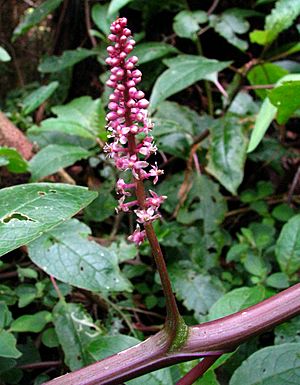Hawai'i pokeweed facts for kids
Quick facts for kids Hawai'i pokeweed |
|
|---|---|
 |
|
| Scientific classification | |
| Genus: |
Phytolacca
|
| Species: |
sandwicensis
|
Phytolacca sandwicensis, also known as Hawai'i pokeweed, is a special plant. It belongs to the Phytolaccaceae family. This plant grows flowers and fruits. It is found only in the Hawaiian Islands. When a plant or animal is found only in one place, it is called endemic. Local people in Hawaii call it pōpolo kū mai.
The Phytolacca plant group has about 25 different types. You can find them in places like North America, South America, East Asia, and New Zealand. But Phytolacca sandwicensis is the only one that lives just in Hawaii.
Hawai'i pokeweed can grow from 1 to over 3 feet tall. It can spread out more than 10 feet wide! Because it grows low and wide, people are starting to use it for landscaping. Native Hawaiians have used this plant for thousands of years. They would crush its berries to make a dark purple dye. This dye was used for tattooing.
The berries of this plant are not safe for humans or most animals to eat. But birds can eat them! Birds have a special way to handle the plant's natural poisons. When birds eat the fruits, they help spread the plant's seeds. You can often find Hawai'i pokeweed in open areas or near creeks. It grows in wet forests. It can live in places from 300 feet to 6500 feet above sea level.
Contents
What Does Hawai'i Pokeweed Look Like?
Phytolacca sandwicensis is not a woody plant. It grows to about 3 feet tall and spreads out 10 feet wide. Its flowers can be dark pink, pink, or white. The flowers grow on a tall spike, which is called an inflorescence. The plant's fruit also grows on this spike. The fruit is usually a dark purple color.
The leaves of the pokeweed are green and oval-shaped. Some leaves are glaborous, which means they are smooth and have no fuzz. Other leaves can be puberulent, meaning they have tiny hairs or fuzz.
Where Does Hawai'i Pokeweed Live?
Hawai'i pokeweed is a land plant. It lives only on the Hawaiian Islands in the Pacific Ocean. It is quite rare to find this plant growing wild. You can find it in open areas or along stream beds. It likes wet or moderately wet forests.
This plant can grow in many different elevations. It lives from about 300 feet up to 6500 feet above sea level. Phytolacca sandwicensis needs a wet environment to grow well. It also needs a moderate amount of sunlight. It can live in very sunny spots. But for landscaping, a little less sun can make the plant look even better. Hawai'i pokeweed also prefers to grow in well-drained soil. This soil can be made of cinder or rich organic material.
Pests and Diseases Affecting Hawai'i Pokeweed
Hawai'i pokeweed can be harmed by certain small creatures. These include ants, scale insects, aphids, and mealy bugs.
- Scale insects are tiny bugs that stick to plants. They drink the plant's sap. They look like small bumps and are sometimes mistaken for a plant disease.
- Mealy bugs are similar to scale insects. They also feed on plant sap. They have a white, waxy outer layer. They gather in bumps that look like a powdery meal.
- Aphids are small insects that also feed on plant sap.
- Ants can cut off parts of the leaves. They take these pieces back to their colonies to eat.
How Hawai'i Pokeweed Is Used
Traditional Uses
Long ago, native islanders used this plant as a dye. They would crush the berries to make a beautiful purple color. This dye was used for tattooing.
Modern Uses
Today, Phytolacca sandwicensis is becoming popular for landscaping. It grows low to the ground and has bright colors. Its unique berry-covered flower spikes make it a great plant for covering large areas. The plant also handles trimming and pruning well.
Is Hawai'i Pokeweed Poisonous?
Yes, Phytolacca sandwicensis is poisonous to humans and most mammals. It is one of the few poisonous plants found in the Hawaiian Islands. The plant has several natural poisons called toxins. The main one is called alkaloid phytolaccine.
If a human or mammal eats the plant, it can cause bad stomach problems. The poison can also affect the central nervous system, which controls your body. It can also stop your body from making new red blood cells.
However, birds can eat the berries and be fine. This is because the hard outer shell of the seeds is not broken when birds eat them. This means the poison inside the seeds is not released. The birds can then pass the seeds through their bodies. This process also helps the plant spread its seeds to new places.

